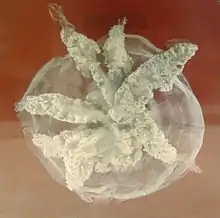Catostylus tagi
Catostylus tagi is a species of jellyfish from warmer parts of the East Atlantic Ocean and since the 2000s also found in the Mediterranean Sea.[1][2] It is the only member of the family Catostylidae that is found in Europe.[3] It has collagen in its bell which is currently being researched to see if it has biomedical uses as an intercellular matrix.
| Catostylus tagi | |
|---|---|
 | |
| Specimen at Musée zoologique de la ville de Strasbourg | |
| Scientific classification | |
| Kingdom: | Animalia |
| Phylum: | Cnidaria |
| Class: | Scyphozoa |
| Order: | Rhizostomeae |
| Family: | Catostylidae |
| Genus: | Catostylus |
| Species: | C. tagi |
| Binomial name | |
| Catostylus tagi Haekel, 1869 | |
Description
Typical Catostylus with chunky appendages and tentacle to go with each. This jellyfish has a sting that causes light pain and a skin rash, but generally poses no serious threat.[3] It is up to 65 cm (26 in) in bell diameter,[4] but a more typical size is 25 cm (10 in) in diameter and 2.5 kg (5.5 lb) in weight.[3] Its colour is variable and can be blue-white, cream, brown, or off-white. The exumbrellar grooves are reddish or purplish brown.[5] C. tagi has gonads along the edge of its stomach in an X shape. It has the octant formation typical of Catostylus jellies, the height of the octants are also variable.
Food
Eats both zooplankton and phytoplankton, certain crustaceans, small fish, and marine snow.
Biomedical use
Its bell collagen is currently being researched for use as an intercellular matrix. The collagen is made up of 1/3 glycine and the most of the rest is water and other amino acids, its amino acid content is very small. The collagen is denatured as soon as it reaches 29.9 °C (85.8 °F).
References
- Brotz, L,; and D. Pauly (2012). Jellyfish populations in the Mediterranean Sea. Acta Adriatica 53(2): 211–230.
- Kienberger, K.; and L. Prieto (2018). The jellyfish Rhizostoma luteum (Quoy & Gaimard, 1827): not such a rare species after all. Marine Biodiversity 48(3): 1455–1462.
- Parracho, T.; and Z. Morais (2015). Catostylus tagi: partial rDNA sequencing and characterisation of nematocyte structures using two improvements in jellyfish sample preparation. J Venom Anim Toxins Incl Trop Dis. 21: 40. doi:10.1186/s40409-015-0037-4
- Palomares, M. L. D. and Pauly, D., eds. (2019). "Catostylus tagi" in SeaLifeBase. June 2019 version.
- Boltovskoy, D., editor (2019). Catostylus tagi. Zooplankton of the South Atlantic Ocean. Marine Species Identification Portal. Retrieved 15 June 2019.
- Boltovsky, T., Bernardo Abiahy, Viviana A. Alder, Martin V. Angel, Renate Bernstein, Dennis Binet, Demetrio Boltovsky, Jean Bouillon, Janet Bradford-Grieve, John-Paul Casanova, Paul Cornelius, Jose R. Dadon, Christina Deponte, Graciela B. Esnal, Maria Alamo, Adilson Fransozo, Mark Gibbons, Ray Gibson, and Cristoph Helemben. "Marine Species Identification Portal : Catostylus tagi." Marine Species Identification Portal : Catostylus tagi. UNESCO, n.d. Web. 24 Sept. 2014.
External links
![]() Media related to Catostylus tagi at Wikimedia Commons
Media related to Catostylus tagi at Wikimedia Commons